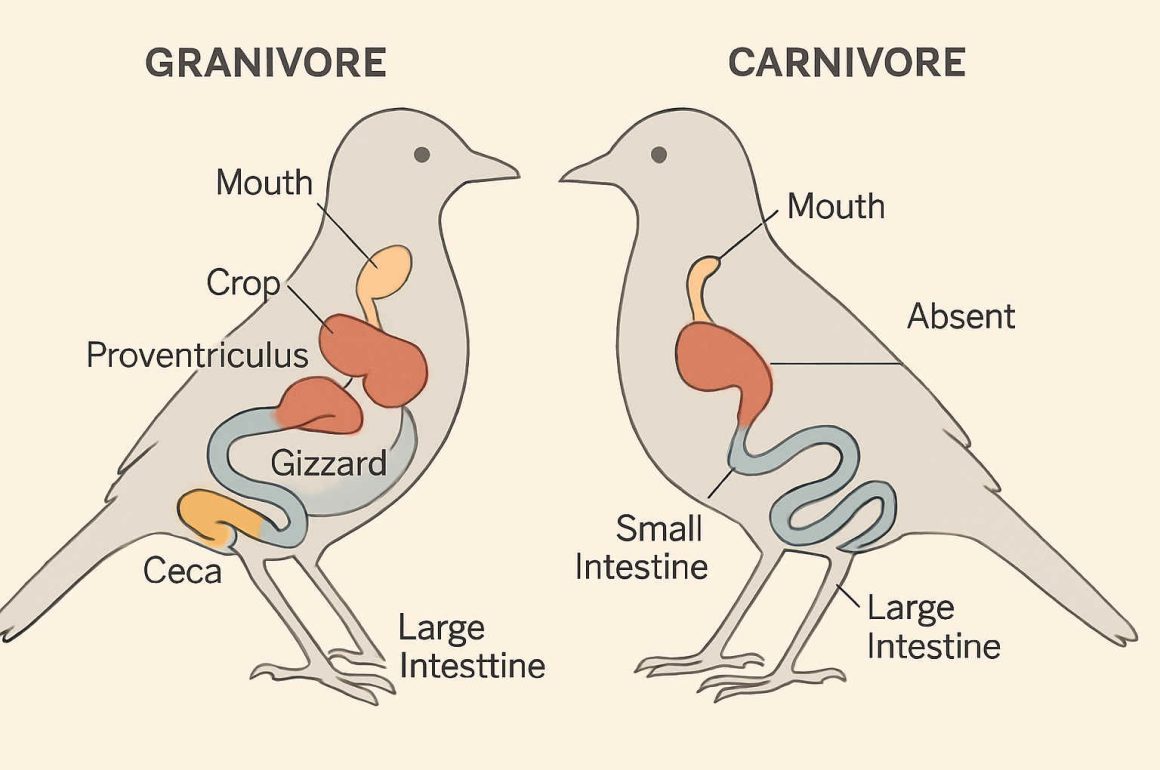
As the other parts of this series, this post focuses on the chemical aspects of avian life – in this case, the chemistry of digestion.
Most food birds eat comes in large chunks – both on a macro level (e.g., whole grains, large pieces of meat) and on a micro level (the individual molecules are typically large polymers, meaning long chains of similar molecules connected by chemical bonds). The main role of chemistry is to cut these long molecules into small ones that can then be absorbed and digested.
The digestive chemistry of birds depends on the specific location, so we need to take a look at the way food passes through the bodies of birds. There are four obligatory stages and two that only apply to some birds.
Step 1: The Mouth (all birds)
This is not a major focus of overall digestion, but the saliva of some birds contains amylase. This is an enzyme that starts breaking down carbohydrates, so it is relevant for birds eating grain (granivores and omnivores).
Chemical Reaction: Breaking down of larger carbohydrates into smaller sugars, catalyzed by amylase.
Step 2: The Crop (some birds)
The crop is mostly used for temporary food storage rather than for digestion. However, in some birds, such as Hoatzins, there is fermentation of food in the crop, which involves enzymes that start breaking down cellulose.
Chemical Reaction: Breaking down of cellulose into smaller sugars, catalyzed by enzymes.
Step 3: The Proventriculus, or Glandular Stomach (all birds)
This is where the chemical digestion really begins. The stomach contains a strong acid, hydrochloric acid, the same as in human stomachs. In their natural state, the proteins in the bird’s food are long chains of amino acids that fold into complex shapes that are stabilized by various interactions that are typically weaker than regular chemical bonds (for example, hydrogen bonds). The acid disrupts these other bonds, and as a result, the proteins unfold (you can imagine a ball of yarn being stretched out, though the analogy is a bit flawed).
Once the proteins have been unfolded, their long (and now more open) chains can be much more easily attacked by enzymes such as pepsin. Via these attacks, the proteins are converted into smaller peptides and amino acids, which the birds can directly use.
There is an interesting side story here. The bird itself consists partly of proteins, so pepsin could start attacking its own proteins as well. Therefore, the stomach does not produce pepsin itself but only an inactive precursor named pepsinogen. Pepsin is only created by the reaction between pepsinogen and hydrochloric acid. The stomach lining is then protected by mucus.
Chemical Reactions:
- Between proteins and hydrochloric acid, leading to the straightening of the protein chains (“denaturation)
- Between hydrochloric acid and pepsinogen, leading to the production of pepsin
- Between pepsin and long-chain proteins in the presence of hydrochloric acid, leading to the production of smaller peptides and amino acids.
So, the proventriculus is almost exclusively responsible for the digestion of proteins rather than the digestion of fats or carbohydrates, the other two main food components. It is thus less important for some families, such as hummingbirds, which mainly live on sugars.
Step 4: The Gizzard, or Muscular Stomach (all birds)
The gizzard is a specialized stomach with thick muscular walls that is used for grinding up food, often aided by particles of stone or grit. It is thus less relevant from a chemical standpoint, though the grinding of the food enhances its surface area and thus increases the surface available for chemical reactions.
Chemical Reaction: None.
Step 5: Small Intestine (all birds)
This is the main site of chemical digestion and absorption. Here, the long molecules of the three major groups of food (carbohydrates, proteins, and fats) are split into small molecules and made absorbable. For each of the three groups, there are specific enzymes (biocatalysts) that facilitate the split into small molecules by letting them react with water (hydrolysis):
These enzymes are proteins delivered by the pancreas. They catalyze specific chemical reactions:
Amylase breaks down starch (a polysaccharide made of glucose) into maltose (a disaccharide) and then further to glucose.
Chemical Reaction: Hydrolysis — amylase uses water to cleave the ?-1,4-glycosidic bonds in starch.
Proteases (trypsin, chymotrypsin) break down proteins into peptides and then amino acids. Similar to the note about pepsin in step 3, these enzymes are secreted by the pancreas in an inactive form (trypsinogen, chymotrypsinogen) to avoid digesting the pancreas itself. Trypsinogen is activated to trypsin by enteropeptidase (another enzyme, made by the intestinal lining). Trypsin then activates more trypsinogen and also chymotrypsinogen.
Chemical Reaction: Hydrolysis of peptide bonds (–CO–NH–) using water.
Lipase breaks down triglycerides (fats) into glycerol + free fatty acids. It works best when fat droplets are emulsified by bile salts (see below).
Chemical Reaction: Hydrolysis of ester bonds between glycerol and fatty acids.
The digestion of fats is supported by bile salts delivered from the liver (with or without intermediate storage in the gallbladder, depending on species). Chemically, these bile salts are amphiphilic molecules, meaning that they are part hydrophilic (water-loving), part hydrophobic (fat-loving). They surround large fat globules and break them into smaller droplets, increasing the surface area for lipase to act. (Molecules in soap do a similar job, helping dissolve fat into water). Note that this is not a chemical reaction.
Step 6: Ceca and Large Intestine (all birds, but large variation in importance)
From a chemical point of view, this step is of lesser importance. In some birds (mainly those eating plants, the ceca have bacteria that ferment some plant material into short-chain fatty acids, which can then be digested. In other birds with diets focusing on meat or nectar, the ceca are small.
The large intestine is short and mainly reabsorbs water. It is present in all birds but is less involved in digestion.
Chemical Reaction: None.
Bird families differ substantially in their main sources of food, and these differences are also reflected in their digestive system and their digestive chemistry. Below is the digestive focus of individual families.
- Carnivores: Protein and the related enzymes (pepsin, trypsin); low importance of carbohydrate enzymes
- Insectivores: Some protein digestion enzymes; an additional enzyme, chitinase, to digest insect exoskeletons
- Granivores such as pigeons: high amylase activity; some cellulase (from gut microbes)
- Nectarivores such as hummingbirds: high sucrase and maltase activity to digest sugars quickly
- Frugivores such as toucans: only moderate amylase and sucrase activity, as they mainly absorb simple sugars.
- Herbivores such as the hoatzin: Large fermentation chambers; high importance of microbial cellulase.
To summarize: birds turn to chemistry to cut the large molecules they get in their food into small molecules that can be absorbed. These small molecules are then either burned for energy or turned back into larger molecules (i.e., become part of the bird’s body). These two then again are chemical reactions.






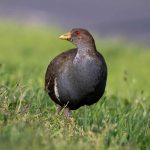
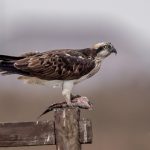
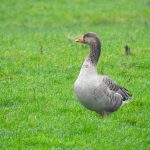

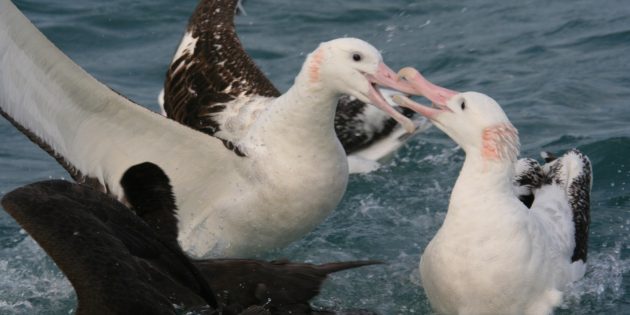
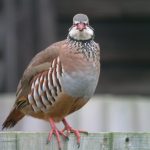
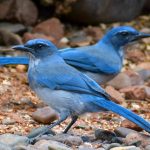
A teacher once explained the unfolding of proteins like turning a crumpled up piece of paper into a flat sheet again. But with the added comment that the paper can only be crumpled back in the exact same manner as it was. I failed that exam, of course, but the analogy stuck. What I do wonder is how the stomach makes that HCl acid and keeps it from leaking into the bird (or me for that matter)?
Frankly, explaining the production of HCl in the body is somewhat complicated and involves using terms such as “oxynticopeptic cells”, which I would rather avoid. The mechanisms to avoid the HCl from doing damage to the stomach are a bit easier to explain: A gel/mucus layer on the stomach walls, some very local bicarbonate buffering (has to be very local, as the acidity in the bulk of the stomach needs to be maintained for effective digestion), and rapid turnover of the cells lining the stomach. Of course, if that does not work, you may get ulcers (humans) or lesions in birds.